

October 12, 2022
By Helen Pritchard
Dr. Helen Pritchard is an early childhood practitioner, lecturer with Manukau Institute of Technology/Te Pūkenga and academic researcher with Workforce Development.
My doctoral research identifies and theorises the nature of transformative experience through a variety of Expressive Arts in early childhood settings. The research draws predominantly on John Dewey’s writings, with Art as Experience (1934/2005) formulating the pedagogical basis for my work.
My intention is to make explicit the term experience and to consider what makes an experience transformative to a degree that can influence teacher’s practice in the arts. Within this research, the children’s experiences must produce change or transformation in perceptions and knowledge for them to be regarded as meaningful, and relevant to their
everyday lives and curiosity.
The teacher as artist sees each connection of doing and undergoing in relation to the whole that they desire the children to experience. They must think in terms of poetic qualities rather than symbols and words.
Play forms an important mode of experience for the child. The joy of knowledge, skills and understanding that comes from Play is transformed into something of meaning, a certain kind of truth for the child. Children’s experiences often begin as imitation, but mimesis is not simply a second version or copy, the children’s recognition of the essence of an aesthetic (or artistic) event becomes a new experience. When meaning is recognised within the work, they achieve a kind of self- representation and this is the beginning of the development of an aesthetic attitude.
Data collection included observations of children engaging in the arts at five early childhood centres in Auckland,
New Zealand. The data helped to identify emerging themes, and highlights how artistic and affective dimensions within arts experiences enable children to encounter new learning challenges and concepts. A phenomenological approach was used to examine the children’s lived experiences and explore the emergent themes.
Music and Movement in Early Childhood Settings
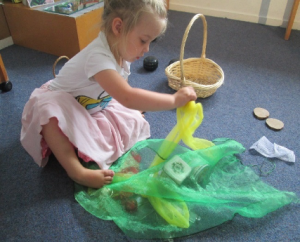
1. Ella’s interest in telling stories caught my attention. She came into the storytelling space, watched the other children for a while and then started gathering materials from the heuristic play resources. She specifically laid them out and began to recite the nursery rhyme Mary, Mary Quite Contrary as she put the assorted items under a green silky chiffon scarf. Ella knew the nursery rhyme well because her teachers had used it at mat time, but she had not sung the song at the centre for some time and so her teachers were amazed that Ella could recall the rhyme so well after so long. Collected experiences developed over time can produce further transformation in how a child thinks, enacts and comes to know.
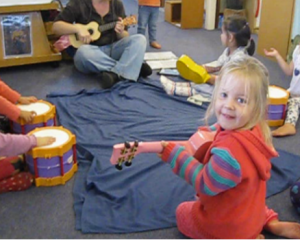
2. Ella sat with a group of six children gathered around a piece of fabric, while their teacher sang and strummed on her ukulele. Ella strummed the ukulele while singing the well-known children’s song The Wheels on the Bus. Her teacher sang and played very slowly, coordinating her singing as she changed chords. Some children were strumming on their ukuleles, while others were intent on feeling the beat using both hands to pat the drums to the rhythm of the words: “up and down” (ta-ta-ta rest). Ella’s engagement in playing music heightened her awareness of the characteristics of instruments as a form of expression.
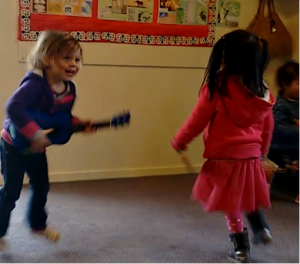
3. The repetitive refrain “Run, run, run, as fast as you can, you can’t catch me I’m the Gingerbread Man” is very catchy. Rosie was motivated to create her own experiences through music and movement. She loved to sing and dance and often asked for a ukulele. The next day the teachers set up a cooking activity and the children made their own gingerbread dough. New ideas surfaced through her interaction with materials, and she created a skateboard as a means for the Gingerbread Man to escape a fox. Rosie used energy of purpose and mimesis in the pretend gingerbread dough, looking like the real thing – there was, therefore, a kind of truth about her activity. She was empowered by the realism of her creation; therefore, this experience was transforming. Rosie recreated the story through singing, playing, dancing and modelling.
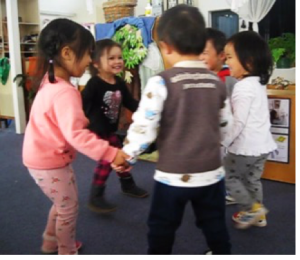
4. Teuila had discovered a space for herself and her friends by holding hands with a group of children and forming a circle. She engaged their participation in the song Ring-a-Roses. As they held hands together and walked in a circle, the children coordinated their movements together. When Teuila sang All fall down, she laughed as her friends all fell to the ground together. Teuila became a dance-maker, an active agent, drawn to respond to music through movement, through her senses —hearing, seeing, and feeling—accompanied with experimental vocalisation and body movement.
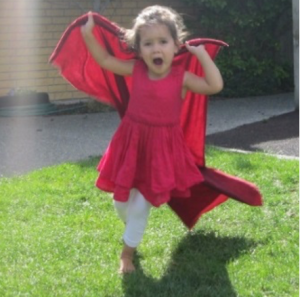
5. Teuila decided to make use of the fabric pieces for her Elsa cape. Many children watched as she performed this dance and expressed her joy in the song. Teuila utilised the relationship between music and gesture, outstretching her arms for the most intense moment, while singing the propelling refrain, Let It Go!At the same time, she spun around, twirling her cape in a full circle. She extended her gestures using the coloured capes. The cape disrupted the original flow, modulating the action into a more complex series of movements. Her costumes and movements showed transformation of energy into thoughtful action. She used dance with conscious intent; she explored new potentials, initiating dance and sharing her joy with children.
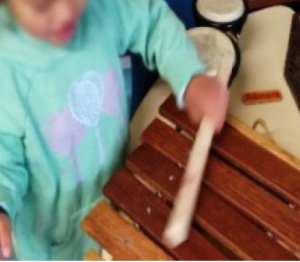
6. In the Aonga Amata, Sefina was attracted to a wooden xylophone, exploring its properties by first removing the bars to inspect its shape and attributes. As she replaced the bar where she’d found it, she picked up a beater to experiment with the available sounds. She was able to control the beater and listened to the beautiful sounds she made by running the beater across the bars. Sefina savoured a descending glissando melody and repeated this several times. She experimented with the affordances of this instrument, discovering rhythm and melody by being creative, expressive, and imaginative. She used the beater to run back the other way, creating an ascending scale and then repeated a rhythm (ta ti-ti ta), discovering a pentatonic melody (do re me so la), back and forth. The aesthetic nature of her composition, with its melodic balance, seemed to entice her further and she sat down on the chair to continue playing.
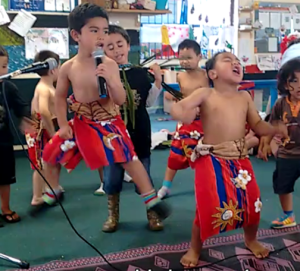
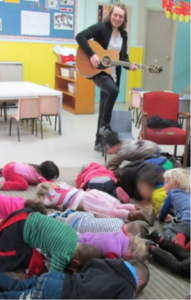
8. A visiting musician invited the children to listen, feel and respond (in this instance, as sleepy fish). Shared songs about the sea and fish were often improvised ‘in the moment’, building on children’s prior experiences. Music and movement enabled the teachers to join the children and re-experience the spontaneous, creative qualities which are seen when children instinctively play. Through their bodies, the children extended their percepts to musical concepts of tempo (fast/slow) dynamics (loud/soft), duration (long/short) pitch (high/low).
The essence of the musical experience is to take the beauty in music to the classroom and cultivate children’s power to listen, to feel and respond. When teachers (as artists) help children to be creative, they will also learn to create for themselves. Being prepared for children’s spontaneity and invention encourages these same qualities by enabling children’s input into the musical story through their imaginative responses.
For Dewey, an experience is an interaction between the child and the environment which, when it is carried to the full, is “transformation into participation and communication” (Dewey, 1934/2005, p.22).
BIO: Dr. Helen Pritchard is an early childhood practitioner, lecturer with Manukau Institute of Technology/ Te Pūkenga and academic researcher with Workforce Development. My doctoral research identifies and theorises the nature of transformative experience through a variety of Expressive Arts in early childhood settings. The research draws predominantly on John Dewey’s writings, with Art as Experience (1934/2005) formulating the pedagogical basis for my work.